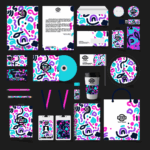
How Graphic Design Can Elevate Your Brand
- blogs
- February 5, 2025
The Power of Visual Storytelling: How Graphic Design Can Elevate Your Brand
In today’s world, it’s not enough for your brand to simply exist—it needs to stand out and speak directly to your audience. And how do you do that? The answer is simple: visual storytelling. With the right mix of colors, imagery, and design, you can communicate your brand’s message in ways words alone can’t.
But what exactly is visual storytelling, and how can it elevate your brand? Let’s dive in!
What is Visual Storytelling?
Visual storytelling is all about using design elements, such as logos, typography, color palettes, and images—to tell a story. It’s the act of conveying your brand’s core message without having to rely heavily on text. Graphic design is your brand’s visual language, and just like any language, it can evoke powerful emotions and connections.
Whether it’s through a stunning logo or an eye-catching Instagram post, design brings your brand’s story to life.
Why Does Visual Storytelling Matter?
In a world where consumers are bombarded by endless messages, your brand needs to break through the noise. And that’s where visual storytelling comes in. Here’s why it’s a game-changer for your business:
- It Makes Your Brand Memorable
Visual storytelling creates something unforgettable. Think about McDonald’s golden arches—those yellow ‘M’s are so iconic that you know exactly what they represent without needing the brand name. That’s the power of great design. By telling your brand’s story visually, you make it easier for people to recognize you instantly.
- It Builds Emotional Connections
Humans are emotional creatures, and emotions drive action. The most powerful stories are those that evoke emotion. Graphic design allows you to tap into those emotions by carefully choosing visuals that resonate with your audience’s desires, needs, or challenges. Whether it’s a warm and inviting color scheme that makes your audience feel safe or a bold and energetic design that ignites excitement, visuals allow you to connect on a deeper level.
For instance, Coca-Cola’s use of red and white instantly invokes feelings of happiness and excitement, while Apple’s sleek, minimalist design conveys sophistication and simplicity. These visuals tell a story of the values behind the brands, influencing how consumers feel about them.
- It Makes Complex Ideas Simple
Not all messages are easy to communicate, especially when dealing with complex products or services. This is where graphic design shines. Want to explain a complicated idea or product? Use visuals!
For example, infographics and illustrations are great ways to simplify data or explain how something works. By presenting information in an easily digestible format, you ensure that your audience understands and remembers your key messages. Graphic design helps break down information into bite-sized, engaging pieces, ensuring that your audience stays interested and understands your message clearly.
- It Creates Consistency Across All Touchpoints
Consistency is a key element of strong brand identity, and it starts with design. Whether your customers are browsing your website, scrolling through Instagram, or watching an ad, your brand’s visual identity should be instantly recognizable. From the colors and fonts to the style of your images, consistency builds trust and reinforces your message across multiple platforms.
Think about iconic brands like Nike. its logo, color palette, and overall design aesthetics is consistent across every platform, making it instantly recognizable.
- It Drives Action and Conversions
Visual storytelling isn’t just about looking good—it’s about moving your audience to action. Whether it’s clicking on a link, signing up for a newsletter, or making a purchase, great design encourages people to take that next step. A compelling call-to-action (CTA) paired with visually engaging elements can guide customers through your funnel, making it easier for them to engage with your brand.
How to Use Graphic Design for Visual Storytelling
Now that we know why visual storytelling is so important, how do you make it work for your brand? Here’s a quick guide:
- Choose the Right Colors
Colors are more than just decoration, they influence emotions. Red, for example, can evoke excitement and urgency, while blue can instill trust and calmness. Think about what emotions you want your brand to convey, and pick a color palette that aligns with those feelings.
- Use Images that Tell a Story
A picture is worth a thousand words—especially when it comes to your brand’s story. The images you use should reflect who you are and what you stand for. Are you fun and quirky? Use bright, playful imagery. Are you a luxury brand? Opt for sleek, high-end visuals. Choose authentic images that resonate with your target audience and reflect your values.
- Use Typography to Reflect Your Brand’s Personality
Fonts play a huge role in visual storytelling. Fonts can convey professionalism, fun, modernity, or elegance—all without saying a word. A bold sans-serif font could express modernity, while a serif font might communicate tradition or sophistication. Make sure your typography complements your brand’s voice.
- Keep Your Design Consistent across all platforms
Consistency is key to making a lasting impression. Whether it’s your website, social media, or print materials, all of your visual assets should share the same style, tone, and color scheme. This helps your audience easily identify your brand and builds recognition over time.
- Ensure Every Design Element Tells a Piece of the Story
Your logo, website, social media posts, and advertising should all feel connected. Every element of your visual identity should come together to tell a cohesive story that represents your brand’s mission and values. This is what creates a unified, recognizable experience for your customers.
Real-World Examples of Visual Storytelling in Action
Here are some iconic brands that have mastered visual storytelling:
- Nike: Their swoosh logo, minimalist design, and powerful use of colors convey a sense of strength, motivation, and empowerment. It’s not just about sports—it’s about being the best version of yourself.
- Apple: Clean, sleek, and modern, Apple’s design is consistent across all touchpoints, from their products to their ads. The simplicity of their design reflects the simplicity and elegance of their products.
- Airbnb: Airbnb’s design brings together real-life images of travelers in real homes, reflecting their core values of authenticity and trust. Their design focuses on the idea that everyone deserves to belong, making it feel like a community.
Conclusion: The Magic of Visual Storytelling
There you have it! Visual storytelling isn’t just about pretty pictures—it’s about creating a lasting, emotional connection with your audience. The power of design lies in its ability to make complex ideas simple, to build brand recognition, and to inspire action.
Are you ready to elevate your brand through the magic of visual storytelling? At Codeness Studio, we specialize in crafting designs that tell your brand’s story in the most compelling way. Let’s create something unforgettable together!
FAQ
Q1: What is visual storytelling in graphic design?
A: Visual storytelling uses design elements like color, typography, and imagery to communicate your brand’s message. It’s a powerful way to connect emotionally with your audience and make your brand memorable.
Q2: How can visual storytelling build brand recognition?
A: Consistent use of design elements across all your marketing platforms creates a cohesive identity that helps your audience instantly recognize your brand, making it unforgettable.
Q3: Can visual storytelling work for small businesses?
A: Absolutely! No matter your business size, visual storytelling is about creating a unique identity that resonates with your target audience. You don’t need a huge budget to make a lasting impact.
Q4: How can I use graphic design to make my brand stand out?
A: Focus on authenticity and consistency. Choose a color palette, typography, and imagery that reflect your brand’s personality and values. Consistency across all platforms will ensure your brand stands out.
Q5: Is it important to update my visual identity over time?
A: Yes, brands often evolve to stay relevant. However, any updates should be done thoughtfully to ensure consistency and maintain your connection with your audience.

